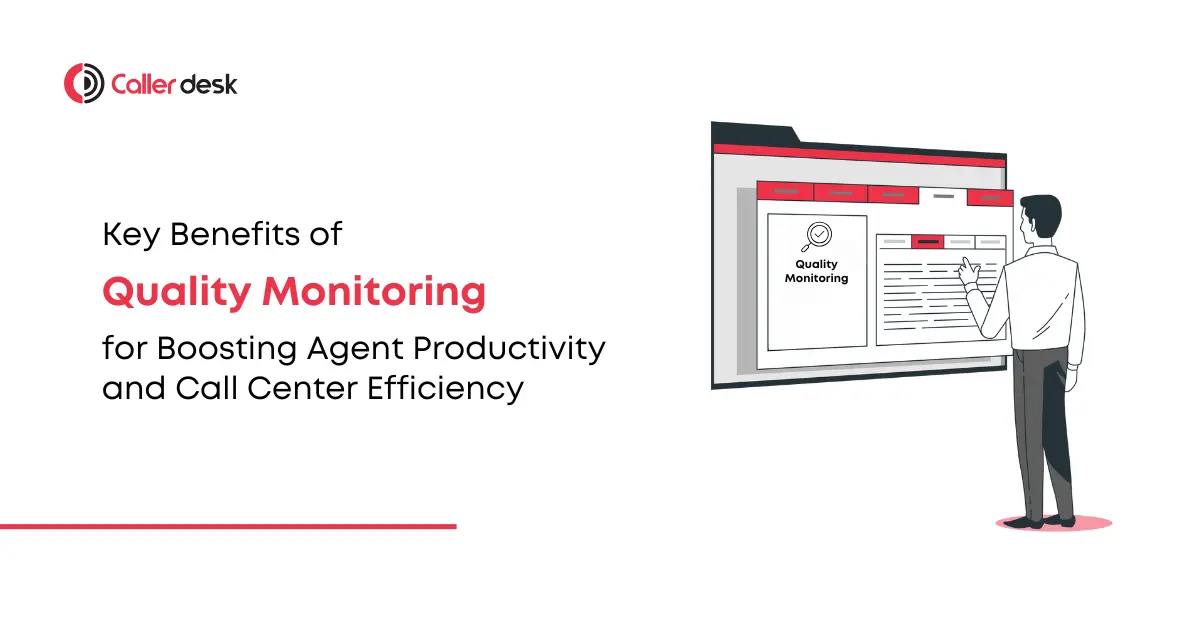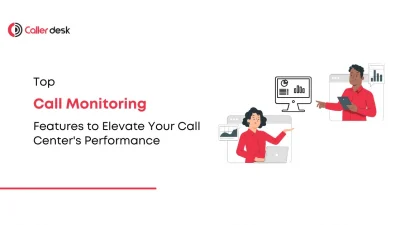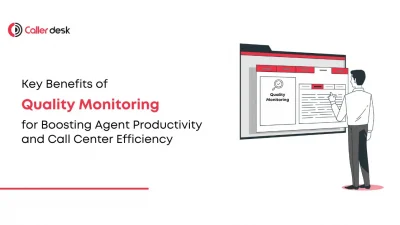Are you looking for ways to enhance your call center’s efficiency while improving agent performance? The answer lies in Quality Monitoring. This powerful tool is designed to evaluate how effectively your agents handle customer interactions, offering valuable insights that drive continuous improvement.
With Quality Monitoring, you can identify communication gaps, streamline processes, and provide targeted feedback to your team. The result? A significant boost in productivity, reduced errors, and elevated customer satisfaction. Whether your goal is to optimize operations, build a stronger workforce, or foster customer loyalty, Quality Monitoring is the ultimate solution.
What is Quality Monitoring?
Quality Monitoring in a call center refers to the systematic evaluation of customer-agent interactions to ensure service excellence. It involves:
- Live and Recorded Call Analysis: Reviewing live calls or recorded interactions to assess communication clarity and adherence to company policies.
- Performance Benchmarking: Evaluating agent performance against predefined standards and key performance indicators (KPIs).
- Feedback and Improvement: Providing agents with actionable insights and coaching to enhance their skills.
At its core, Quality Monitoring aims to deliver exceptional customer service while boosting operational efficiency. Let’s explore how it benefits call centers in detail.
Key Benefits of Quality Monitoring
1. Enhancing Customer Experience
At the heart of every call center operation is the customer. Quality Monitoring ensures that every interaction meets or exceeds customer expectations. By evaluating customer-agent interactions, call centers can:
- Identify Common Pain Points: Such as long wait times, unclear communication, or unresolved issues.
- Improve Response Quality: Agents become more equipped to handle queries quickly and effectively, leaving customers satisfied.
Example:
Imagine a customer calling for technical support. The agent struggles to explain the solution, leaving the customer frustrated. Through Quality Monitoring, managers can identify such issues, provide training on technical communication, and ensure future interactions are smoother.
Outcome: A personalized and efficient customer experience that fosters loyalty and strengthens your brand reputation.
2. Boosting Agent Performance
Agents are the backbone of any call center, and their performance directly impacts the quality of service. Quality Monitoring helps:
- Highlight Strengths and Weaknesses: Managers can identify areas where agents excel and where they need support.
- Provide Tailored Coaching: Training sessions can be customized based on individual agent needs, focusing on specific skills such as empathy, problem-solving, or technical expertise.
Pro Tip: Celebrate achievements by recognizing top-performing agents. Recognition boosts morale and motivates agents to maintain high standards.
Result: A confident and skilled team that delivers consistent, high-quality service.
3. Improving Operational Efficiency
Operational bottlenecks can slow down service and frustrate customers. Quality Monitoring provides actionable insights to:
- Reduce Call Durations: Identify unnecessary steps or repetitive tasks that prolong interactions.
- Increase First-Call Resolution (FCR): Ensure agents have the tools and knowledge to resolve issues during the first interaction.
- Streamline Workflows: Address inefficiencies in call routing, resource allocation, or escalation processes.
Example:
A call center struggling with long handling times discovers, through Quality Monitoring, that agents spend too much time on after-call documentation. Implementing an automated call logging system reduces this time, boosting efficiency.
Outcome: Faster service, reduced costs, and happier customers.
4. Supporting Compliance and Quality Assurance
Industries like finance, healthcare, and telecom require strict adherence to regulatory standards. Quality Monitoring ensures:
- Compliance with Regulations: Agents follow data protection laws, industry standards, and company guidelines.
- Risk Mitigation: Regular monitoring identifies potential compliance risks before they escalate.
Example:
A financial services call center uses Quality Monitoring to ensure agents adhere to GDPR guidelines when handling customer data. Non-compliance is flagged, and corrective action is taken promptly.
Impact: Enhanced customer trust and reduced risk of legal complications.
5. Informing Key Metrics & KPIs
Quality Monitoring directly contributes to the tracking and improvement of critical KPIs, including:
- First-Call Resolution (FCR): Measures the percentage of issues resolved on the first call.
- Customer Satisfaction (CSAT): Gauges how happy customers are with the service.
- Net Promoter Score (NPS): Indicates customer loyalty and likelihood of recommending your service.
- Average Handling Time (AHT): Tracks the average time agents spend on calls.
Pro Tip: Use CallerDesk’s analytics tools to monitor these metrics in real-time, making data-driven decisions to improve performance.
6. Reducing Agent Turnover
Agent turnover is a costly issue for call centers. High stress, lack of recognition, and limited growth opportunities often lead to dissatisfaction. Quality Monitoring helps:
- Reduce Stress: By providing agents with clear guidelines and feedback.
- Boost Engagement: Structured coaching sessions and regular feedback keep agents motivated.
- Enhance Job Satisfaction: Empower agents with the skills and confidence needed to excel in their roles.
Result: A happier workforce and lower recruitment costs.
7. Identifying Opportunities for Improvement
Beyond individual performance, Quality Monitoring uncovers operational inefficiencies or missed opportunities. For instance:
- Service Gaps: Highlight areas where processes need improvement.
- Upselling and Cross-Selling Opportunities: Identify moments where agents could offer additional products or services.
Example:
Monitoring reveals that agents often miss opportunities to upsell during billing inquiries. Managers introduce training sessions focused on identifying and leveraging these moments, boosting revenue.
8. Helping with Recruitment and Hiring
Insights from Quality Monitoring can improve recruitment efforts by:
- Identifying Top Agent Traits: Such as empathy, adaptability, and problem-solving skills.
- Highlighting Team Needs: Addressing skill gaps to hire candidates who complement the existing team.
Impact: Building a high-performing, well-rounded team from the outset.
How CallerDesk Enhances Quality Monitoring
With CallerDesk, implementing and optimizing Quality Monitoring becomes seamless. Key features include:
- Real-Time Analytics: Track agent performance and key metrics in real time.
- Comprehensive Reporting: Generate detailed reports to gain actionable insights.
- Customizable Dashboards: Visualize data to identify trends and areas for improvement.
- Automated Feedback Loops: Deliver constructive feedback directly to agents for continuous growth.
Conclusion
Quality Monitoring is a game-changer for call centers looking to enhance agent productivity and operational efficiency. By evaluating customer interactions, identifying strengths and weaknesses, and providing actionable feedback, businesses can achieve measurable success.
With CallerDesk’s advanced tools, you can simplify the process of monitoring, improving customer satisfaction, and ensuring consistent service quality. Embrace Quality Monitoring today and transform your call center into a hub of excellence.
Frequently asked questions
1. What is quality monitoring in a call center?
Quality monitoring is the process of evaluating customer-agent interactions to ensure high service standards. It involves reviewing calls, analyzing agent performance, and providing feedback to improve customer service and operational efficiency.
2. Why is quality monitoring important for call centers?
Quality monitoring helps call centers enhance customer satisfaction, boost agent performance, ensure compliance with industry standards, and improve overall operational efficiency. It provides actionable insights for continuous improvement.
3. What are the key benefits of quality monitoring?
Key benefits include improved customer satisfaction, enhanced agent performance, operational efficiency, compliance assurance, and reduced agent turnover. It also helps identify training needs and service gaps.
How does quality monitoring help in reducing agent turnover?
By providing agents with regular feedback, personalized coaching, and opportunities for growth, quality monitoring fosters job satisfaction and reduces stress, which helps lower agent turnover rates.
How can CallerDesk enhance quality monitoring?
CallerDesk offers advanced tools like real-time analytics, customizable dashboards, and automated feedback loops to simplify quality monitoring. These tools help track performance, improve service quality, and ensure compliance efficiently.





